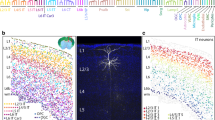Abstract
The aims of the present work were to identify the neuronal form of nitric oxide synthase (nNOS type I) in brain structures in rats by immunocytochemistry, to compare the results with data from histochemical reactions for NADPH-diaphorase, and to develop the optimal conditions for fixation for detecting nNOS. The product of the histochemical reaction was found to be located strictly in the cytoplasm. Immunocytochemical detection of nNOS showed that along with the cytoplasmic reaction for nNOS, the nuclei of some neurons and gliocytes were immunopositive, though the cytoplasm of these cells gave negative reactions for nNOS. Selection of the optimal fixation conditions for specimens and the dilution of the primary antibody allowed reductions in the intensity of nuclear nNOS-type reactions without affecting the specific reaction of the cytoplasm for nNOS. These data provide evidence that the best detection of nNOS in paraffin sections is obtained using immersion fixation in Carnoy’s fluid or post-fixation in this solution after perfusion with 4% paraformaldehyde.
Similar content being viewed by others
References
V. G. Bashkatova and K. S. Raevskii, “Nitric oxide in the mechanisms of brain damage induced by the neurotoxic action of glutamate,” Biokhimiya, 63, 1020–1028 (1998).
D. É. Korzhevskii, “Estimation of NADPH-diaphorase activity in the rat brain after fixation of different durations,” Morfologiya, 109, No. 3, 76–77 (1996).
D. É. Korzhevskii, “Use of monoclonal antibodies to nuclear protein PCNA to identify proliferating cells in the developing human brain,” Morfologiya, 118, No. 5, 68–70 (2000).
D. É. Korzhevskii, I. P. Grigor’ev, and V. A. Otellin, “Use of dehydrating fixatives containing zinc salts in neurohistological studies,” Morfologiya, 129, No. 1, 85–87 (2006).
A. Bishop and J. E. Anderson, “NO signaling in the CNS: from the physiological to the pathological,” Toxicology, 208, No. 2, 193–2005 (2005).
M. Gilchrist, S. D. McCaulay, and A. D. Befus, “Expression, localization, and regulation of NOS in human mast cell lines: effects on leukotriene production,” Blood, 104, No. 2, 462–269 (2004).
F. X. Guix, I. Uribesalgo, M. Coma, and F. J. Munoz, “The physiology and pathophysiology of nitric oxide in the brain,” Prog. Neurobiol., 76, No. 2, 126–152 (2005).
D. D. Kim, A. M. Pica, R. G. Duran, and W. N. Duran, “Acupuncture reduces experimental renovascular hypertension through mechanisms involving nitric oxide synthases,” Microcirculation, 13, No. 7, 577–585 (2006).
E. R. Matarredona, M. Murillo-Carretero, B. Moreno-Lopez, and C. Estrada, “Role of nitric oxide in subventricular zone neurogenesis,” Brain Res. Brain Res. Rev., 49, No. 2, 355–366 (2005).
F. Rothe, U. Canzler, and G. Wolf, “Subcellular localization of the neuronal isoform of nitric oxide synthase in the rat brain: a critical evaluation,” Neurosci., 83, 259–269 (1998).
R. Saini, R. Saluja, A. A. Sahasrabuddhe, et al., “Nitric oxide synthase localization in the rat neutrophils: immunocytochemical, molecular, and biochemical studies,” J. Leukoc. Biol., 79, No. 3, 519–528 (2006).
Z. Yuan, B. Liu, L. Yuan, et al., “Evidence of nuclear localization of neuronal nitric oxide synthase in cultured astrocytes of rats,” Life Sci., 74, No. 26, 3199–3209 (2004).
K. Zvarova and M. A. Vizzard, “Distribution and fate of cocaine-and amphetamine-regulated transcript peptide (CARTp) expressing cells in rat urinary bladder: a developmental study,” J. Comp. Neurol., 489, No. 4, 501–517 (2005).
Author information
Authors and Affiliations
Additional information
__________
Translated from Morfologiya, Vol. 132, No. 4, pp. 77–80, July–August, 2007.
Rights and permissions
About this article
Cite this article
Korzhevskii, D.É., Otellin, V.A., Grigor’ev, I.P. et al. Immunocytochemical detection of neuronal NO synthase in rat brain cells. Neurosci Behav Physi 38, 835–838 (2008). https://doi.org/10.1007/s11055-008-9063-9
Received:
Published:
Issue Date:
DOI: https://doi.org/10.1007/s11055-008-9063-9




